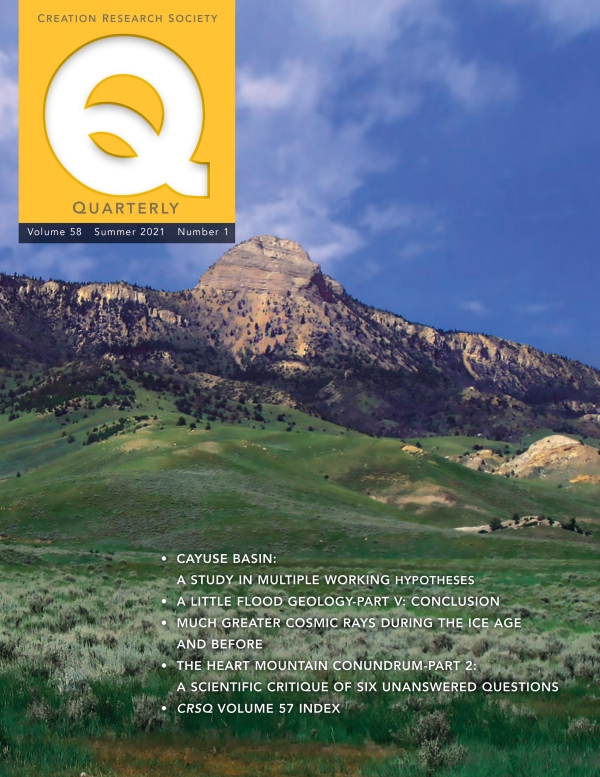
ABSTRACTS
The Heart Mountain Conundrum, Part 2: A Scientific Critique of Six Unanswered Uniformitarian Questions
John D. Matthews
Heart Mountain, Wyoming, USA, is a geological puzzle. “Paleozoic” carbonates overlie “much younger Mesozoic and Cenozoic” rock. The implication is that several mountain sized blocks broke from a detachment fault and slid up to 45 km. Part 1 of this series critiqued recent models that propose low-friction cushions to move the Heart Mountain blocks. This paper compliments that study by examining how the proposed movement started and was sustained over uneven terrain via seven questions raised by uniformitarian researchers. Current models, uniformitarian and creationist, cannot explain the location of Heart Mountain as a detachment and slide. Unless fresh ideas are forthcoming, the implication that these “Paleozoic” rocks of Heart Mountain are younger, not older, than the underlying “Mesozoic” rocks needs exploring
Cayuse Basin: A Study in Multiple Working Hypotheses
Peter Klevberg
Impact craters in the landscape and subsurface have received increasing attention in recent decades, particularly after popularization of the impact theory for the demise of the dinosaurs. Diluvialists also debate the possible role of impacts in the Genesis Flood. Thus, both uniformitarians and diluvialists have been on the lookout for more impact craters. In 2012, we investigated a candidate crater, Cayuse Basin in Judith Basin County, Montana. While we did not discover evidence for a crater, the process itself provided good lessons for both impact enthusiasts and detractors.
Much Greater Cosmic Rays During the Ice Age and Before [open Access]
Michael J. Oard
The RATE project was a huge breakthrough for creation scientists. It especially explained why secular scientists get millions and billions of years from radiometric dating. Quaternary dating methods also need evaluating. One of these dating methods is cosmogenic nuclide dating caused by the bombardment of the Earth by cosmic rays. Production rates of cosmogenic nuclides vary by location on the Earth, altitude, and time and depend upon many variables. They have many geological applications, such as inferring erosion rates and the burial rates of sediments. Carbon-14 is the most well known cosmogenic dating method, but it has a practical age limit to only 50 ka. In situ beryllium-10 (10Be or Be-10) can be easier to use and can ‘date’ the rest of the Quaternary. Another cosmogenic dating method calculates the ratio of Al-26/Be-10 in sediment, which can determine the time since burial. Seven Be-10 measurements are used as showcases for an old Earth. They produce tens to hundreds of thousands of years in the uniformitarian timescale. When transforming the Be-10 values into Biblical earth history, creation scientists run into four complications which make it impossible to be accurate. In spite of this, it appears that the cosmic rays were very high during the Flood and tailed off rapidly during the Ice Age. These measurements have four implications: 1) high cosmic rays could be due to a nearby supernova or supernovae that may also be a cause for accelerated radiometric decay during the Flood and Ice Age; 2) it accounts for the rapid increase in C-14 after the Flood; 3) accelerated radiometric decay after the Flood telescopes other Quaternary dating methods to the time after the Flood; and 4) finally, we can account for the Be-10 measurements in ice cores.
A Little Flood Geology Part V: Conclusion
Peter Klevberg
Part I argued that floods are an important category of geologic processes and showed that hydraulic relationships are nonlinear, resulting in episodic rather than continual geologic change. Part II presented field examples from central Montana in 2011. Part III used information from the central Montana projects to show that geologic processes range from slow and localized to episodic and regional (even unique and global). Geologic paradigms can negatively impact field work for both uniformitarians and diluvialists. These negative effects can be avoided by the “mixed question” approach and “multiple working hypotheses.” In Part IV, limitations of extrapolating from local floods to megafloods and from scientific observation to natural history speculation were discussed. Here, evidence is summarized to highlight some important principles to guide geologic research.
